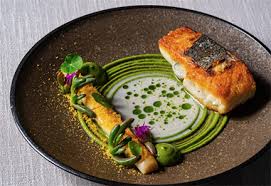Introduction:
Natural food coloring in high-end dining is becoming increasingly popular as chefs and restaurants seek to enhance the visual appeal of their dishes while maintaining a commitment to natural and sustainable ingredients. Here are some insights into how natural food coloring is used in high-end dining:
1.) Types of Natural Food Colorings
a. Fruit and Vegetable Extracts:
- Beet Juice: Provides a vibrant red or pink color.
- Carrot Juice: Adds orange hues.
- Spinach Powder or Kale Extract: Imparts green tones.
- Blueberry or Acai Extract: Offers brilliant shades of blue or purple.
b. Herbs and Spices:
- Turmeric: Gives a bright yellow color.
- Paprika: Adds a reddish-orange hue.
- Matcha (Green Tea Powder): Offers a deep green color.
c. Natural Dyes from Flowers:
- Hibiscus Powder: Creates a rich red or pink.
- Saffron: Provides a deep yellow to orange tint.
- Butterfly Pea Flower Extract: Known for its vibrant blue color that can turn purple with acidity changes.
d. Root Powders:
Annatto: Offers an orange to yellow color.
2. Applications in High-End Dining
a. Plating and Garnishes: Chefs use natural colorants to create visually stunning plates. For instance, beet powder might be used to paint a plate or as a component in a dish, enhancing the visual experience.
b. Sauces and Purees: Natural colorings are integrated into sauces and purees to create visually appealing contrasts. For example, a vibrant green spinach puree might accompany a dish to add both flavor and color.
c. Desserts: High-end desserts often use natural colorings to avoid synthetic dyes. For example, matcha can be used in cakes or pastries to give a rich green color, while beet juice can color icings or mousses.
d. Drinks: Natural colorings are used in cocktails and non-alcoholic beverages to enhance their appearance without relying on artificial dyes.
e. Artistic Elements: Some chefs create intricate designs or edible art on plates using natural colorings, demonstrating skill and creativity while maintaining a focus on natural ingredients.
3. Benefits of Using Natural Colorings
a. Healthier Option: Natural colorings are generally perceived as healthier and less likely to cause allergic reactions compared to synthetic dyes.
b. Sustainable and Ethical: Many natural colorings come from sustainable sources, aligning with the eco-friendly practices of high-end dining establishments.
c. Flavor Integration: Natural colorings often come with subtle flavors, allowing them to enhance the dish not just visually but also gastronomically.
4. Challenges
a. Stability and Consistency: Natural colorings can be less stable and might change color when exposed to heat, light, or acidity, requiring careful handling.
b. Cost: High-quality natural colorings can be more expensive than synthetic alternatives, which can impact the cost of ingredients in high-end dining.
c. Limited Range: The range of natural color options is not as broad as synthetic dyes, which can limit color possibilities.
In high-end dining, the use of natural food coloring reflects a commitment to quality, aesthetics, and ethical practices. Chefs and culinary artists leverage these natural ingredients to create dishes that are both visually stunning and aligned with contemporary dining values.

